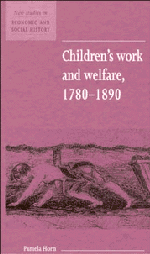1 - Introduction: 1780–1850s
Published online by Cambridge University Press: 04 August 2010
Summary
Differing perspectives of childhood and child employment
At the end of the eighteenth century two opposing philosophies underpinned contemporary attitudes towards childhood. The first, and most widely held, stemmed from a belief in the innate sinfulness of all humanity and the consequent need to curb and control youthful high spirits. Habits of industry must be inculcated since ‘idleness’ was equated with moral weakness, and each child had to be trained so as to ensure that the correct values and beliefs were absorbed.
For the upper classes this disciplined approach meant an emphasis on drudging memory work and the ‘culture of the mind’ (Cruickshank, 1981). For the lower orders, it led to concern to promote early employment, either paid or unpaid. The educational writer and reformer, Mrs Sarah Trimmer, reflected these ideas when she declared in 1787 that it was ‘a disgrace to any Parish, to see the Children of the Poor, who are old enough to do any kind of work, running about the streets ragged and dirty’. Likewise the Philanthropic Society, set up in 1788 to rescue criminal or abandoned children, regarded ‘indolence’ as the prime source of evil and ‘industry’ as the principal virtue. This not only encouraged acceptance of child labour in agriculture, mining, manufacture and, especially for girls, in domestic service but it encouraged the promotion of schools of industry and similar educational institutions in the last decades of the eighteenth century.
- Type
- Chapter
- Information
- Children's Work and Welfare 1780–1890 , pp. 1 - 11Publisher: Cambridge University PressPrint publication year: 1995



